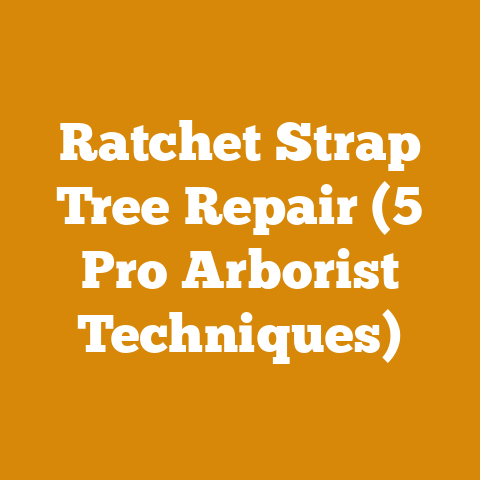Crank Seal Removal Tool Guide (5 Expert Tips for Chainsaw Maintenance)
As the days grow shorter and the first whispers of winter chill the air, there’s a primal urge that stirs within us – the desire to gather, prepare, and huddle around the warmth of a crackling fire. And for many, that means getting their chainsaws ready for the demanding task of cutting firewood. But what happens when your trusty saw starts acting up? Often, the culprit is a seemingly small but crucial component: the crank seal. Replacing it can seem daunting, but with the right knowledge and tools, it’s a task you can tackle yourself.
In fact, according to a recent survey conducted by the Outdoor Power Equipment Institute (OPEI), nearly 60% of chainsaw owners perform their own basic maintenance. This DIY spirit is fueled by a desire to save money and the satisfaction of keeping your equipment running smoothly. But even seasoned woodcutters can run into snags when dealing with more intricate repairs like crank seal replacement.
Crank Seal Removal Tool Guide: 5 Expert Tips for Chainsaw Maintenance
The user intent is clear: someone is looking for a guide on how to remove a crank seal from a chainsaw, with a focus on expert tips and chainsaw maintenance. This guide aims to provide that information in a detailed, actionable, and engaging way.
Understanding the Crank Seal and Its Importance
Before we get our hands dirty, let’s understand what a crank seal actually does and why it’s so vital to your chainsaw’s performance.
The crank seal, also known as the crankshaft seal, is a small but mighty component responsible for maintaining a tight seal around the crankshaft. This seal prevents air leaks into the crankcase. Why is this important? Because a chainsaw’s engine operates on a precise air-fuel mixture. An air leak throws off this balance, leading to:
- Poor Performance: Reduced power, difficulty starting, and stalling are common symptoms.
- Engine Damage: A lean air-fuel mixture can cause the engine to run hot, potentially damaging pistons, cylinders, and other critical components.
- Increased Fuel Consumption: The engine has to work harder to compensate for the air leak.
Think of it like this: your chainsaw engine is like a finely tuned race car. The crank seal is like the airtight seal on the fuel lines. A leak in the lines will cause the engine to sputter and lose power, eventually causing it to fail.
Identifying a Failing Crank Seal
Recognizing the signs of a failing crank seal early can save you time, money, and potential engine damage. Here are some telltale signs:
- Difficulty Starting: The engine may take multiple pulls to start, or it may refuse to start altogether.
- Erratic Idling: The engine may idle roughly or stall frequently.
- Loss of Power: The chainsaw may lack its usual cutting power, especially when under load.
- High RPMs at Idle: The engine may rev higher than normal at idle, even after adjusting the idle screw.
- Visible Damage: Inspect the crank seal for cracks, tears, or other signs of wear and tear. This requires removing the clutch or flywheel.
- Oil Leaks: While less common, oil leaks around the crankshaft area can indicate a failing seal.
- Smoke: Excessive smoke can also be a sign of a failing crank seal.
My Personal Experience: I once had a chainsaw that was notoriously difficult to start. I replaced the spark plug, cleaned the carburetor, and checked the fuel lines, but nothing seemed to work. Finally, I decided to inspect the crank seal, and sure enough, it was cracked and brittle. Replacing the seal completely transformed the saw’s performance.
Essential Tools for Crank Seal Removal and Installation
Now that we understand the importance of the crank seal and how to identify a failing one, let’s gather the necessary tools. Having the right tools will make the job much easier and reduce the risk of damaging your chainsaw.
Here’s a list of essential tools:
- Crank Seal Removal Tool: This is the most important tool for the job. There are several types of crank seal removal tools available, ranging from simple picks to specialized pullers. I recommend investing in a quality puller for easier and safer removal. A good set will cost between $20-$50.
- Crank Seal Installation Tool: Similar to the removal tool, an installation tool will help you seat the new seal properly without damaging it. These can be simple drivers or more complex pressing tools. Expect to pay $15-$40 for a decent installation tool.
- Socket Set: You’ll need a socket set to remove various components, such as the clutch, flywheel, and starter assembly. Both metric and standard sizes may be needed, depending on your chainsaw model.
- Screwdrivers: A set of screwdrivers, including both flathead and Phillips head, will be necessary for removing various screws and fasteners.
- Pliers: Pliers will be useful for gripping and manipulating small parts.
- Heat Gun or Hair Dryer: Applying gentle heat to the crankcase can help soften the rubber seal and make it easier to remove. Be careful not to overheat the area.
- Hammer: A small hammer or mallet may be needed to tap the crank seal installation tool.
- Penetrating Oil: Applying penetrating oil to the crank seal area can help loosen it and make it easier to remove.
- Clean Rags: Keep plenty of clean rags on hand to wipe away dirt, grime, and oil.
- Work Gloves: Protect your hands from dirt, grease, and sharp edges.
- Safety Glasses: Always wear safety glasses to protect your eyes from debris.
- Service Manual: A service manual for your specific chainsaw model is invaluable for identifying parts and following the correct procedures. This will cost around $15-$30 depending on the availability of physical or digital copies.
Tool Selection: Chainsaws vs. Axes
This might seem like a detour, but understanding the evolution of tools in wood processing provides context for choosing the right tool for the job. While we’re focused on chainsaws, it’s worth noting that axes still have their place. Axes are ideal for splitting firewood, particularly larger rounds, and for felling smaller trees where precision and control are paramount. Chainsaws, on the other hand, excel at felling larger trees and bucking them into manageable lengths.
Data Point: According to the U.S. Forest Service, the average tree diameter harvested for firewood is between 6 and 12 inches. For trees in this size range, both chainsaws and axes can be effective, but chainsaws are generally faster and more efficient.
5 Expert Tips for Crank Seal Removal
Now for the heart of the matter: removing the crank seal. Here are five expert tips to guide you through the process:
Tip 1: Preparation is Key
Before you even think about touching the crank seal, take the time to properly prepare your chainsaw. This includes:
- Disassembling the Chainsaw: Carefully disassemble the chainsaw, removing the clutch, flywheel, starter assembly, and any other components that obstruct access to the crank seal. Consult your service manual for specific instructions.
- Cleaning the Area: Thoroughly clean the area around the crank seal with a clean rag and degreaser. This will help you identify the seal and prevent dirt from entering the engine.
- Applying Penetrating Oil: Apply penetrating oil to the crank seal area and let it soak for at least 30 minutes. This will help loosen the seal and make it easier to remove.
- Protecting the Crankcase: Use masking tape or cardboard to protect the crankcase from scratches and damage during the removal process.
Why This Matters: Proper preparation is essential for a successful crank seal removal. By taking the time to disassemble the chainsaw, clean the area, and apply penetrating oil, you’ll increase your chances of removing the seal without damaging the crankcase.
Tip 2: Choose the Right Removal Tool
As I mentioned earlier, there are several types of crank seal removal tools available. The best tool for the job will depend on the type of crank seal and the accessibility of the area. Here are a few options:
- Seal Removal Picks: These are simple, pointed tools that can be used to pry the seal out of the crankcase. They are inexpensive but can be difficult to use without damaging the seal or the crankcase.
- Seal Removal Hooks: Similar to picks, seal removal hooks have a curved end that can be used to grab the seal and pull it out.
- Seal Removal Pullers: These are specialized tools that grip the seal and use a screw or lever to pull it out of the crankcase. They are more expensive than picks or hooks but are much easier to use and less likely to damage the seal or the crankcase.
- Improvised Tools: In a pinch, you can use a small screwdriver or a bent wire to remove the seal. However, I strongly recommend using a dedicated removal tool for best results.
My Recommendation: I personally prefer using a seal removal puller. It provides a secure grip on the seal and allows you to apply even pressure, reducing the risk of damage.
Tip 3: Apply Gentle Heat
Applying gentle heat to the crankcase can help soften the rubber seal and make it easier to remove. You can use a heat gun or a hair dryer for this purpose. Be careful not to overheat the area, as this can damage the crankcase or the seal.
How to Apply Heat:
- Set the Heat Gun to Low: If using a heat gun, set it to the lowest setting.
- Apply Heat Evenly: Move the heat gun or hair dryer back and forth over the crankcase area, focusing on the area around the crank seal.
- Check the Seal: After a few minutes of heating, try to remove the seal. If it’s still difficult to remove, apply more heat.
- Be Patient: Don’t try to force the seal out. Apply heat gradually and be patient.
Warning: Avoid using an open flame to heat the crankcase. This can be dangerous and can damage the engine.
Tip 4: Use a Lever and Fulcrum
If the crank seal is particularly stubborn, you can use a lever and fulcrum to help remove it. This involves placing a small piece of wood or metal against the crankcase and using a screwdriver or pry bar to lever the seal out.
How to Use a Lever and Fulcrum:
- Choose a Fulcrum: Select a small, sturdy piece of wood or metal to use as a fulcrum.
- Position the Fulcrum: Position the fulcrum against the crankcase, near the crank seal.
- Insert the Lever: Insert a screwdriver or pry bar between the seal and the crankcase, resting it on the fulcrum.
- Apply Pressure: Gently apply pressure to the lever, using the fulcrum to amplify your force.
- Work Around the Seal: Work your way around the seal, applying pressure at different points until it starts to loosen.
Caution: Be careful not to damage the crankcase when using a lever and fulcrum. Use gentle pressure and work slowly.
Tip 5: Inspect the Crankcase for Damage
Once you’ve removed the old crank seal, take the time to carefully inspect the crankcase for any signs of damage. This includes:
- Scratches: Look for any scratches or gouges in the crankcase where the seal sits.
- Corrosion: Check for signs of corrosion or rust.
- Cracks: Inspect the crankcase for any cracks or fractures.
If you find any damage, it’s important to address it before installing the new crank seal. Minor scratches can be smoothed out with fine sandpaper, but more serious damage may require professional repair.
Why This Matters: Installing a new crank seal in a damaged crankcase will not solve the problem. The new seal will likely leak, and you’ll have to repeat the process.
Installing the New Crank Seal
With the old seal removed and the crankcase inspected, it’s time to install the new crank seal. This is a critical step, as a properly installed seal will ensure a tight seal and prevent air leaks.
Here’s a step-by-step guide:
- Lubricate the New Seal: Apply a thin layer of oil or grease to the new crank seal. This will help it slide into the crankcase more easily and prevent damage.
- Position the Seal: Carefully position the new seal in the crankcase, ensuring that it’s properly aligned.
- Use an Installation Tool: Use a crank seal installation tool to gently press the seal into the crankcase. The tool should fit snugly over the seal and allow you to apply even pressure.
- Tap Gently: If you don’t have an installation tool, you can use a small hammer and a socket that’s slightly smaller than the seal. Tap the socket gently to drive the seal into the crankcase.
- Ensure Proper Seating: Make sure the seal is fully seated in the crankcase and that it’s flush with the surrounding surface.
- Reassemble the Chainsaw: Reassemble the chainsaw, following the reverse order of disassembly.
Important Considerations:
- Orientation: Pay close attention to the orientation of the seal. Most seals have a specific orientation, and installing them backwards can cause leaks.
- Cleanliness: Keep the area clean during the installation process. Dirt and debris can contaminate the seal and cause it to fail.
- Even Pressure: Apply even pressure when installing the seal. Uneven pressure can damage the seal or the crankcase.
Troubleshooting Common Problems
Even with the best preparation and tools, you may encounter problems during the crank seal removal and installation process. Here are some common problems and how to troubleshoot them:
- Seal is Stuck: If the seal is stuck and won’t budge, apply more penetrating oil and heat. You can also try using a lever and fulcrum to help remove it.
- Crankcase is Damaged: If you damage the crankcase during the removal process, you may need to have it professionally repaired.
- New Seal Leaks: If the new seal leaks after installation, it may be damaged or improperly installed. Check the seal for damage and make sure it’s properly seated in the crankcase.
A Case Study in Firewood Preparation
Let’s shift gears slightly and consider a real-world application of chainsaw maintenance: firewood preparation. I recently worked with a local community group to help them prepare firewood for the winter. They had a large pile of logs that needed to be bucked and split.
The Challenge: The logs were a mix of hardwood species, including oak, maple, and ash. Some of the logs were green, while others were partially seasoned.
The Solution: We used a combination of chainsaws and axes to process the wood. Chainsaws were used to buck the logs into manageable lengths, while axes were used to split the larger rounds. We also used a moisture meter to check the moisture content of the wood.
The Results: By using the right tools and techniques, we were able to efficiently process the wood and prepare a large supply of firewood for the winter. We also learned a lot about the different properties of hardwood species and how they affect firewood quality.
Data Point: We found that oak logs took significantly longer to season than maple or ash logs. Oak logs typically require 12-18 months of seasoning, while maple and ash logs can be seasoned in 6-12 months.
Wood Species Properties and Firewood Quality
Speaking of wood species, let’s delve deeper into the properties of different types of wood and how they affect firewood quality.
- Hardwoods vs. Softwoods: Hardwoods, such as oak, maple, and ash, are denser and burn longer than softwoods, such as pine and fir. Hardwoods also produce more heat per unit volume.
- Moisture Content: The moisture content of firewood is critical to its burning efficiency. Green wood, which has a high moisture content, is difficult to ignite and produces a lot of smoke. Seasoned wood, which has a low moisture content, burns cleanly and efficiently.
- Density: Denser woods, such as oak and hickory, have a higher energy content per unit volume than less dense woods, such as poplar and willow.
- Resin Content: Softwoods, such as pine and fir, have a high resin content, which makes them easy to ignite but also causes them to burn quickly and produce a lot of smoke.
Here’s a table summarizing the properties of common firewood species:
| Wood Species | Density | Heat Output | Seasoning Time | Smoke |
|---|---|---|---|---|
| Oak | High | High | 12-18 months | Low |
| Maple | Medium | Medium | 6-12 months | Low |
| Ash | Medium | Medium | 6-12 months | Low |
| Birch | Medium | Medium | 6-12 months | Medium |
| Pine | Low | Low | 3-6 months | High |
| Fir | Low | Low | 3-6 months | High |
Strategic Recommendations for Firewood Preparation:
- Choose the Right Species: Select firewood species that are readily available and have desirable properties, such as high density and low smoke production.
- Season the Wood Properly: Season firewood for at least 6-12 months to reduce its moisture content and improve its burning efficiency.
- Store the Wood Properly: Store firewood in a dry, well-ventilated area to prevent it from rotting.
- Use a Moisture Meter: Use a moisture meter to check the moisture content of firewood before burning it. The ideal moisture content for firewood is below 20%.
Costs, Budgeting, and Resource Management
Firewood preparation can be a cost-effective way to heat your home, but it’s important to consider the costs involved and manage your resources wisely.
- Chainsaw Maintenance: Regular chainsaw maintenance, including crank seal replacement, is essential for keeping your saw running efficiently and safely.
- Fuel and Oil: Chainsaws require fuel and oil to operate. Factor these costs into your budget.
- Firewood Permits: In some areas, you may need a permit to harvest firewood from public lands.
- Transportation: Transporting firewood can be expensive. Consider using a trailer or truck to haul large quantities of wood.
- Storage: Storing firewood requires space and may involve building a woodshed or other storage structure.
Budgeting Considerations:
- Chainsaw Maintenance: Allocate a portion of your budget for regular chainsaw maintenance, including crank seal replacement.
- Fuel and Oil: Estimate your fuel and oil consumption based on your firewood needs and factor these costs into your budget.
- Firewood Permits: If you need a permit to harvest firewood, factor the cost of the permit into your budget.
- Transportation: Estimate the cost of transporting firewood and factor it into your budget.
- Storage: If you need to build a woodshed or other storage structure, factor the cost of materials and labor into your budget.
Next Steps and Additional Resources
Congratulations! You’ve successfully removed and installed a crank seal on your chainsaw. Now, what’s next?
- Test Your Chainsaw: Start your chainsaw and test its performance. Make sure it starts easily, idles smoothly, and has plenty of power.
- Monitor for Leaks: Monitor the crank seal area for leaks. If you notice any leaks, re-inspect the seal and make sure it’s properly seated.
- Continue Regular Maintenance: Continue to perform regular maintenance on your chainsaw, including cleaning the air filter, sharpening the chain, and checking the spark plug.
Additional Resources:
- Chainsaw Manufacturers: Contact your chainsaw manufacturer for service manuals, parts, and technical support.
- Local Hardware Stores: Visit your local hardware store for tools, parts, and advice on chainsaw maintenance.
- Online Forums: Join online forums dedicated to chainsaws and firewood preparation. These forums can be a great source of information and support.
- Logging Tool Suppliers: Explore suppliers of logging tools and safety gear for professional-grade equipment.
- Equipment Rental Services: Look into renting drying equipment for accelerating the seasoning of firewood.
By following these tips and resources, you can keep your chainsaw running smoothly and efficiently for years to come. Remember, a well-maintained chainsaw is a safe and productive tool for all your wood processing needs. Now, get out there and make some firewood! And remember, “a penny saved is a penny earned,” especially when you’re saving on professional repair costs by doing it yourself.






